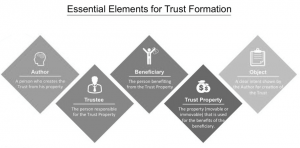In this blog post, Arvind Radhakrishnan, a partner at Synacrity Advisors LLP and a student pursuing a Diploma in Entrepreneurship Administration and Business Laws from NUJS, Kolkata, details the enforcement of the rights of beneficiaries in a public charitable trust.
Introduction
Benign in concept and charitable in spirit, Trusts and Trust Law have all-the-same been wielded as instruments of non-compliance to promote ulterior motives since they came into existence. Indeed, the first Trust akin in nature and meaning of the modern term was formed in the 19th century by John D. Rockefeller as a means of concentrating the power (read: shares) of the then largest global corporation – Standard Oil – into the hands of a few, with himself owning approximately 41% of the entire entity.[i] Beginning with an overview of Trusts and Trust Law in India, as is governed by The Indian Trusts Act, 1882 (among others)this article aims to give the reader an overview of the specific roles played by the different parties involved in a Trust structure, with particular attention paid to how beneficiaries of a Public Charitable Trust can effectuate their rights under the law, should these rights be exploited or abused. – Source: IndiaFilings[ii]
In layperson terms, a Trust can be formed when the owner of some property, be it immovable or movable, transfers ownership of this property to a third party with the express intention of holding on to it for the benefit of others. In this definition, these entities are, in the order mentioned, the “author of the trust”, the “trust property”, the “Trustee” and the “beneficiaries” (Note that it is possible for the author and the trustee to be the same person, if allowed by the relevant courts).While this broad definition applies to all forms of Trusts; Private and Public Trusts can be differentiated by their chosen beneficiaries and the laws that govern each form. Simply put, if the beneficiaries of the Trust are a select group of individuals rather than the general public, the Trust will be deemed Private and will be governed largely by the Indian Trusts Act, 1882. If the greater public stands to gain, however and are therefore explicit or implicit beneficiaries of the Trust, a Public Charitable Trust can be formed, and this would be governed by the Public Trust Act applicable in the relevant State. In the absence of a Public Trust Act in that state, the applicable legislation will be the Indian Trusts Act 1882.[iii] 
Trust purposes that would allow for the creation of a Public Charitable trust, rather than a Private Trust, include “(i) Relief of Poverty or Distress, (ii) Education, (iii) Medical Relief, (iv) Provision of facilities for recreation or other leisure-time occupation and (v) The advancement of any other object of general public utility, excluding purposes which relate exclusively to religious teaching or worship” (ibid). Important to note here is that with a Public Charitable Trust, if a valid trust has been created and the property has been transferred to the trust, it cannot be revoked.
In illustrating the means by which a beneficiary’s rights can be enforced, it pays first to describe these rights, the duties of those who act in the beneficiaries’ interest (trustees) and the ways in which these rights can be exploited.
The Rights of Beneficiaries
The rights of the beneficiaries are largely subject to the provisions of the instrument of trust. In the absence of specific mention, however, certain key rights apply (The stated rights have been paraphrased from the official wording of the Act):
- Rights to rents and profits
- Right to specific execution of the intention of the author to the extent of the beneficiary’s interest, even if this includes transferring the trust property to the beneficiary (if he is competent).

- Right to inspect and take copies of the instrument of trust, its accounts, related documents and cases or opinions taken by the trustee as and when required by him to execute his duties.
- Right to transfer beneficial interest –If the beneficiary is competent to contract he or she may transfer his or her interest to another party, subject to any constraints indicated in the Trust Deed and under the guidance of the applicable laws currently in force.
- Right to sue for execution of trust –If no trustee is available to execute the trust in the manner intended, the court may be allowed by the beneficiary to perform such services instead, at least until a suitable and competent trustee is appointed.
- Right to proper trustees –The beneficiary has a right (subject to the provisions of the instrument of trust) that the trust property shall be properly protected and held and administered by proper persons and by a proper number of such persons. Note that as per the law, entities abroad, insolvent or with interests against the beneficiaries’ are not allowed to be made trustees.
- Right to compel to any act of duty –The beneficiary has the right to expect that the trustee will perform all required duties as specified by the relevant laws and Trust Deed, and that said trustee would not commit anything amounting to a breach of trust.
The Duties of Trustees
As the executioners of a Trust Deed, Trustees hold a great deal of power over and responsibility towards both the author of the trust, to fulfill his intended purpose, and the beneficiaries, who are the Trust’s ultimate recipients. Whether intended or otherwise, failing to execute his or her duties effectively towards the fulfillment of a Trust’s purpose could constitute a breach of trust on the part of a Trustee, and is a ground for legal recourse. What follows is a curated list of rights that are most susceptible to cases where a breach of trust could occur:
- Trustee to execute trust – Except for any and all impractical, illegal or otherwise immoral activities, the trustee is bound to act to fulfill the purpose of the trust in line with the instructions given by the author at the time of the Trust’s creation.

- Trustee to protect title to trust property – Subject to the provisions of the instrument of trust or Trust Deed, a trustee is required to take all reasonable steps and actions to maintain and defend all suits that may be relevant to preserve the trust property and its title.
- Trustee not to set up title adverse to beneficiary –As always, the beneficiaries interests must be addressed and upheld and the trustee must not in any way threaten the title of the trust property in a way that negatively affects the beneficiary’s interests.
- Care required from trustee–A trustee must treat the trust property as carefully as if that property were his own. Provided this has been done, and if there is no provision or contract that specifies otherwise, the trustee cannot be held responsible for any losses, destruction or deterioration of the trust property.
- Trustee to prevent waste – Related to point 2 above, there are several beneficiaries in a Trust, but any single one has possession of the trust property, the trustee is required to take any reasonable measures to prevent actions that would be destructive, whether temporarily or permanent, to the trust property.
- Accounts and information–A trustee is required (a) to keep clear and accurate accounts of the trust property especially relating to its amount and state, and (b) to provide these details in as accurate a form, as and when required by the beneficiary.
- Investment of trust money – Where the trust property consists of money, the trustee is required, either by the applicable laws or the explicit instructions in the trust deed or instrument, the document to not invest trust money in any other securities.
Consequences of Breach
With the above sections giving an overview of the Public Charitable Trust structure, and the rights& duties of the two most important groups within that structure – the Beneficiaries and the Trustee – we now turn to the consequences of the breaches of trust, as well as the specific strategies beneficiaries can use to assert their rights.
 As per the Indian Trusts Act, 1882, the beneficiary had the right to compel the trustee to perform any particular act of his duty and restrained from committing any contemplated or probable breach of trust[iv]. However, if it is found that a breach of trust has been committed, the Trustee is liable to “make good the loss which the trust-property or the beneficiary has thereby sustained, unless the beneficiary has by fraud induced the trustee to commit the breach, or the beneficiary, being competent to contract, has himself, without coercion or undue influence having been brought to bear on him, concurred in the breach, or subsequently acquiesced therein, with full knowledge of the facts of the case and of his rights as against the trustee.”[v]
As per the Indian Trusts Act, 1882, the beneficiary had the right to compel the trustee to perform any particular act of his duty and restrained from committing any contemplated or probable breach of trust[iv]. However, if it is found that a breach of trust has been committed, the Trustee is liable to “make good the loss which the trust-property or the beneficiary has thereby sustained, unless the beneficiary has by fraud induced the trustee to commit the breach, or the beneficiary, being competent to contract, has himself, without coercion or undue influence having been brought to bear on him, concurred in the breach, or subsequently acquiesced therein, with full knowledge of the facts of the case and of his rights as against the trustee.”[v]
Note that a trustee committing a breach of trust is not liable to pay interest except under certain provisions explicitly laid out in the Act. Further, some provisions exist in the Act to indemnify the Trustee to some extent if another person gained from a breach of Trust, if the liability arose from a predecessor’s or co-trustee’s actions, and a few other situations.
Enforcement of Rights
When a breach of trust is suspected, and a beneficiary’s rights violated, either (i) the Advocate General or (ii) two or more persons having an interest in the trust and having obtained the leave of the court, can institute a suit to seek 1 of 6 potential legal recourse actions[vi]:
- removal of a trustee
- appointment of a new trustee
- for vesting any property in a trustee
- for directing a trustee who has been removed or a person who has ceased to be a trustee to deliver possession of any trust property in his possession to the person entitled to the possession of such property
- for directing accounts inquiries
- for seeking of declaring what proportion of the trust property or the interest therein shall be allocated me any particular object of the trust.
In such a suit, the court may alter the original purpose of the trust if it deems necessary. This will occur if either the original purpose of the trust is fulfilled or cannot be carried out or where the original purpose of the trust provides a use for only part of the trust property or where the property of the trust can be used more effectively for another similar purpose.
The Court can also make an alternation of the original purpose if it deems that the nature or purpose or activities of the trust have changed such that it does not fulfill the definition of a public charitable trust anymore.
[divider]
References:
[i]Barak Orbach and Grace E. Campbell Rebling, 2012, “The Antitrust Curse of Bigness”, 85 S. Cal. L. Rev. 605
[ii]IndiaFilings, 2016, “How to Form a Charitable Trust”, Available at http://www.indiafilings.com/learn/how-to-form-a-charitable-trust/
[iii]CA Rajkumar S. Adukia, 2016,“Handbook on Laws Governing Formation and Administration of Charitable Organizations in India”, Available at http://www.caaa.in/image/hb-charitable_org.pdf
[iv] IndiaCorpLaw, 2014, “Rights of MBS Bondholders Against the Company: Part 2″, Available at http://indiacorplaw.blogspot.in/2014/01/guest-post-rights-of-mbs-bondholders_23.html
[v]Vakilno1, 2016, “The Indian Trusts Act, 1882”, Available at http://www.vakilno1.com/bareacts/indiantrustsact/indiantrustsact.html#Chapter_IV_8211_OF_THE_RIGHTS_AND_POWERS_OF_TRUSTEES
[vi]Advocate Khoj, 2016, “Law Library – Trust”, Available at: http://www.advocatekhoj.com/library/lawareas/trust/public.php?Title=Trust&STitle=Public,%20charitable%20and%20religious%20trusts










